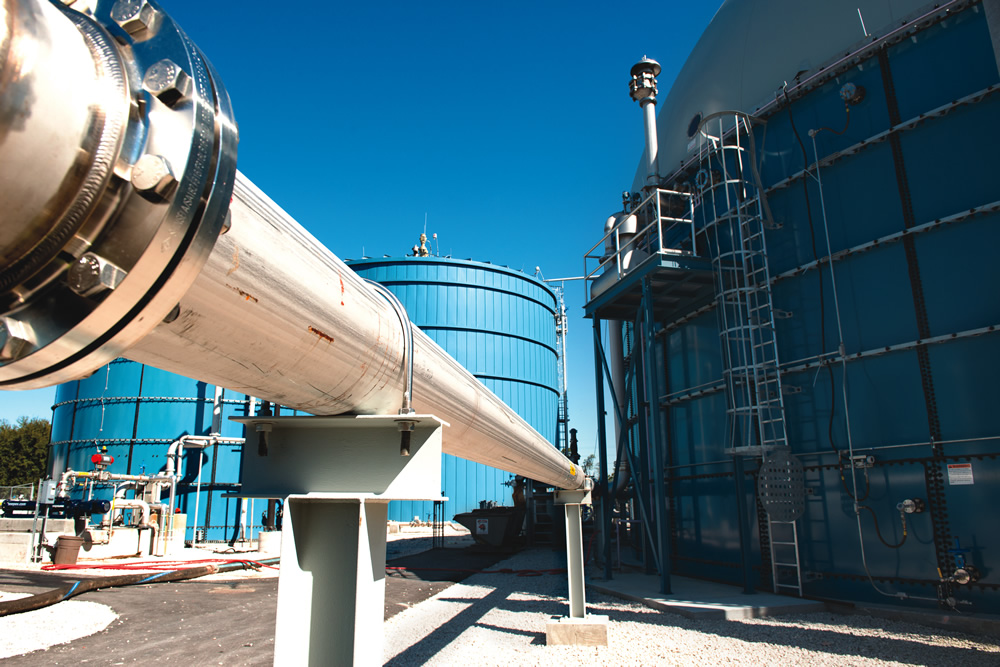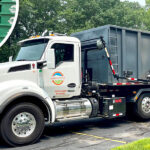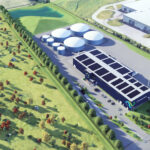New digester in the Orlando region processes 130,000 tons/year of biosolids, fats, oils, grease and food waste, producing power, a Class AA granular fertilizer and phosphorous-rich struvite.
Meredith Sorensen
BioCycle March/April 2014
What is today a region in Central Florida teeming with theme parks, resorts, golf courses and over 50 million tourists annually was once an area considered too remote and uninhabitable for recreation-oriented development. Primarily woods and wetlands, the 25,000 acres about 20 miles southwest of Orlando was so secluded that the nearest power and water lines were 10 to 15 miles away. To help solve this predicament, the Florida legislature created the Reedy Creek Improvement District (RCID) in 1967 for the purpose of advancing the state’s economic growth by facilitating development of a world-class tourist destination. In less than three years, RCID installed roads, water lines, power and communication lines, as well as services such as water and wastewater treatment, electric generation and distribution systems. In 1971, Walt Disney World, along with two hotels, opened their doors.
Today 43 hotels and resorts representing more than 40,000 rooms and 2.4 million square feet of convention space along with hundreds of restaurants exist within RCID. In 2010, RCID invited Harvest Power, based in Waltham, Massachusetts, to evaluate the District’s composting system. Simultaneously, RCID’s wastewater consultant evaluated and then recommended anaerobic digestion for managing biosolids and food waste. Harvest Power then proposed a codigestion system to recover energy and nutrients from food waste, manage odors, process RCID’s biosolids and improve the fertilizer end product quality. Its proposal was accepted, and in late 2013, Harvest’s Energy Garden came on line. The anaerobic digestion facility, located at RCID’s 20 MGD wastewater treatment plant (WWTP), has capacity to process 130,000 tons/year of organic waste material and generate approximately 3.2 MW of installed power and 2.2 MW of recoverable heat from a biogas-fueled combined heat and power system (CHP).
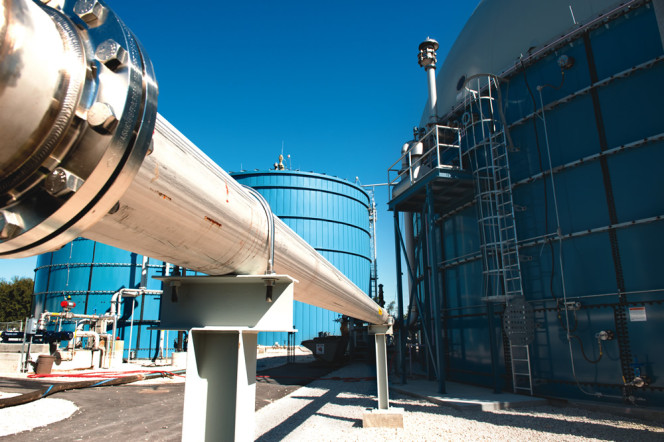
The codigestion facility includes a mixing tank, two complete mix anaerobic digesters operated in parallel, and a post digestion tank with a biogas holder mounted to the top (seen at right).
“Turning organic waste into clean energy was a logical next step,” explains Bill Warren, administrator for RCID. “We are always looking for innovative ways to conserve natural resources and protect the environment.”
Two factors influenced the construction approach: First, RCID required rigorous performance standards. Second, investment tax credits under the federal Section 1603 financing program for renewable energy projects generating electricity required that all systems be operating by the end of December 2013. Harvest Power managed the project development including environmental permitting (air and biosolids/wastewater permit from the Florida Department of Environmental Protection, storm water permit from RCID and South Florida Water Management District), construction and term financing, contracting engineering and construction coordination, and feedstock acquisition.
Incoming feedstocks include biosolids, fats, oils and grease (FOG), and source separated food waste from industrial, commercial and institutional (IC&I) sources including local theme parks, hotels, restaurants and food processors. Harvest Power reached out to local haulers to prepare them for the increased demand for organic waste collection routes. Outreach and education training sessions were held with hotel and restaurant staff. In addition, educational materials such as informational posters and food waste collection bins were provided.
To build the facility, Harvest Power chose a design-build approach using Layne Inc. Heavy Civil as the lead in an Engineering, Procurement, Construction (EPC) contract. “It was an absolute necessity to have a single point of responsibility given the project’s complexity, its financing structure, short engineering and construction time and rigorous performance standards,” notes Alex MacFarlane, Vice President of Project Development at Harvest Power. Entec Biogas GmbH provided core process design on the anaerobic digestion and biogas management systems.
Facility Operation
Source separated organics and packaged food waste are received in an enclosed building. Materials are preprocessed to remove inorganic material through mechanical separation. Scott Equipment supplied the depackaging system. Minimal dilution water is added to create a slurry, which is then pumped to a mixing tank and blended with the other organics streams (biosolids and FOG). From the mixing tank, the blended feedstock is heated and pumped into one of two complete mix anaerobic digester tanks operated in parallel. Retention time in the digestion tanks is under 28 days. After digestion, the effluent is stored in a post-digester tank to complete digestion. A double-membrane biogas holder is mounted to the top of the post-digester tank to collect, store and regulate the pressure of the biogas generated. The biogas is conditioned to reduce hydrogen sulfide and moisture prior to combustion in a 3.2 MW CAT CHP engine-generator system.
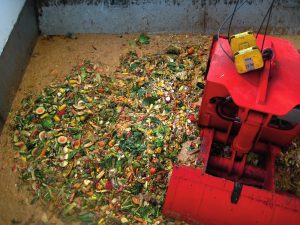
Source separated organics and packaged food waste from local theme parks, hotels, restaurants and food processors are received in an enclosed building.
As of early March 2014, the facility produces 15,000 cubic meters/day of biogas, all of which is fed into the CHP unit. The power is being used to produce electricity for internal use (parasitic load) and for sale to RCID for WWTP operations. The high temperature heat from the CHP is used for indirect drying of digestate with thermal oil; hot water is used for process heating.
The effluent (digestate) from the post-digester is separated into a solid and liquid stream using a dewatering centrifuge. The solid residual “cake” is dried to create about 6,600 tons/year of granular fertilizer product that meets EPA Class AA or EQ quality for a product containing biosolids. (Prior to opening this facility, the biosolids were composted by RCID.) The liquid or “centrate” is treated to recover and reduce nutrient concentrations before discharge back to the WWTP. No centrate is recycled back to the front end to make the slurry. Phosphorus is recovered from the liquid centrate stream using a struvite reactor to create a solid struvite fertilizer pellet. The liquid is further treated to reduce biological oxygen demand (BOD) and total nitrogen using an anammox sequencing batch reactor prior to discharge back to the WWTP.
“One problem with codigestion is that nutrients, particularly nitrogen and phosphorus, can be released back to the treatment plant,” explains MacFarlane. “Managing those nutrient levels is extremely important. With the struvite for phosphorus and annamox for nitrogen removal, we are using a fraction of the consumables and energy to minimize treatment load back to the WWTP, while making a valuable fertilizer (struvite).”
Outreach And Education
The facility made its debut on the cover of the Orlando Sentinel featuring the headline, “Food Scraps Help Slate Disney’s Power Needs: A Feast of Electricity and Fertilizers,” with a follow up launch of an “Orlando or Landfill? We Choose Orlando” community engagement program designed to encourage responsible food recovery. Part of the community engagement includes a ticker on the Energy Garden website counting the amount of food waste sent to the local landfill — 24 pounds per second (last dataset). In addition, kitchen staff at participating restaurants, resorts and hotels are trained on what materials get diverted into the organics collection containers. Finally, window cling badges with “Responsible Food Recovery” signal the restaurant or hotel’s participation to patrons.
Since the initial announcement, additional high profile customers have signed on including the Waldorf Astoria Hilton Hotels with its seven local restaurants, and Freshpoint Central Florida, North America’s largest fresh produce distributor, and the JW Marriott Orlando. Harvest’s longer term plans include expansion of the source separation program to Orange County’s school cafeterias. And while power is being generated from the biogas at this time, the company is investigating use of the renewable natural gas as a fuel for resort vehicles.
Meredith Sorensen is the Director of Communications for Harvest Power, Inc.


